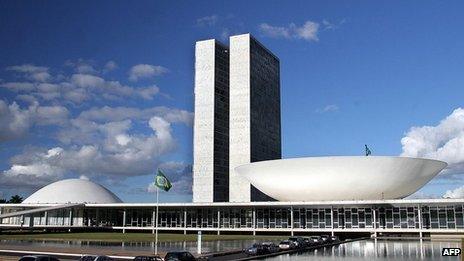Oscar Niemeyer, Brazilian architect, dies at 104
- Published
Niemeyer designed some of the 20th Century's most famous modernist buildings
Brazilian architect Oscar Niemeyer, who designed some of the 20th Century's most famous modernist buildings, has died just before his 105th birthday.
He rose to international fame as the architect of the main government buildings in the futuristic Brazilian capital, Brasilia, inaugurated in 1960.
He also worked with Swiss-born modernist architect Le Corbusier on the UN building in New York.
He continued to work on new projects until earlier this year.
He died on Wednesday at a hospital in Rio de Janeiro.
A memorial service will be held in the presidential palace in Brasilia on Thursday.
Niemeyer's family was informed of the honour in a phone call from President Dilma Rousseff.
"Brazil has lost today one of its geniuses, It is a day to lament his death. It is a day to acclaim his life."
Rio de Janeiro's Mayor Eduardo Paes has declared three days of mourning in Niemeyer's home city.
It is thought he will be buried there on Friday.
Inspirational women's curves
Oscar Niemeyer started his career in the 1930s, when Brazil was still copying neoclassical European architecture and designing ornate palace-like buildings.

Niemeyer said his stylised swoops were inspired by Brazilian women's curves
His bold futuristic designs in Brasilia made the new capital a dramatic statement of confidence in the future of Brazil, and an icon of modern architecture.
A student of Le Corbusier, he developed a distinctive style defined by stark concrete and sweeping curves.
He famously once said the stylised swoops in his buildings were inspired by the curves of Brazilian women.
"When you have a large space to conquer, the curve is the natural solution," he said.
"I once wrote a poem about the curve. The curve I find in the mountains of my country, in the sinuousness of its rivers, in the waves of the ocean and on the body of the beloved woman."
A firm communist - and a personal friend of Cuban leader Fidel Castro - Niemeyer left the country during Brazil's military dictatorship and forged an international career in France.
In 1988, he was awarded the prestigious Pritzker Prize.
British architect Lord Norman Foster, who designed London's Gherkin tower and the dome on the Reichstag building in Berlin, described Niemeyer as an "inspiration" who "stood accepted wisdom on its head".
Recounting how the two had met in Rio last year, he said: "It seems absurd to describe a 104 year old as youthful, but his energy and creativity were an inspiration."
"He told me that architecture is important, but that life is more important. And yet in the end his architecture is his ultimate legacy.
"Like the man himself, it is eternally youthful - he leaves us with a source of delight and inspiration for many generations to come."
However, Niemeyer's style was not to everyone's taste, and for a communist some people say his work was not very people-friendly - focusing more on the architecture's form than on its inhabitants or functionality.
He went on to create more than 600 buildings around the world. His legacy endures in museums, monuments, schools and churches in Brazil and beyond.
Many of the designs were initially sketched on a table overlooking his beloved Rio de Janeiro and its famous Copacabana beach, replete with the women, waves and hills from which he drew such inspiration.
- Published6 December 2012
- Published6 December 2012